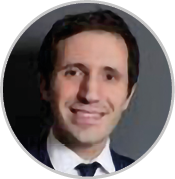Deep Dive into M&A Activity in the European Healthcare Services Industry
We have seen many different trends driving M&A activity in the European Healthcare Services industry over recent years. Some, such as consolidation, remain consistent, while other new trends have developed not only because of the increasingly challenging economic conditions, but as new markets have opened. We look more closely at what has been happening in four of the key market segments and identify areas of opportunity for investors over the coming years.


DAVID AMAR
Managing Director
Degroof Petercam — IMAP France
david.amar@imap.com
European Medical Lab Testing
M&A Recovery Possible in Fragmented Geographies Once Economic Uncertainty Settles
Consolidation has been driving the European medical lab testing market for several years now, attracting financial sponsors (both Private Equity and Infrastructure funds) looking for high and stable EBITDA-to-cash conversion.
Large European geographies such as France and, to a lesser extent, Germany, have reached a high level of consolidation: with multiples skyrocketing in 2021 and H1 2022, notably driven by a scarcity of targets: in 2021, EQT purchased Cerba for €4.5 billion i.e. 12.9x EBITDA, Cerba acquired Lifebrain (largest Italian player) for €1.3 billion i.e. 13.3x EBITDA and APMoeller acquired Unilabs for €5 billion i.e. 13.1x EBITDA, making it the largest M&A transaction in the medical lab testing sector in Europe, ever.
In April of the same year, Synlab completed its IPO. This was a primary IPO with a €400 million share issue, completed by the sale of some existing shareholders' shares (Cinven, NOVO Nordisk Foundation, Ontario Teachers' Pension Plan, Dr. Bartl Wimmer, and Management). The IPO took place during a period of growth for Synlab with the objective of refunding part of its debt. Despite Synlab's recent strong results, the IPO was completed at €18.0 per share (which was at the lower end of the range initially expected, €18.0 - €23.0, i.e., a market capitalization of €4 billion and an Enterprise Value of €5.8 billion, mainly due to a lack of investor appetite).
The second half of 2022 marked the end of the party for the sector, with a landscape characterized by numerous uncertainties: (i) The war in Ukraine and inflation led to a strong tightening of financing conditions, (ii) COVID test volumes dropped to levels below what was expected as the long-term recurring activity, (iii) Social Security in countries such as France and Switzerland imposed sharp price cuts to lower the burden of public spending. Such uncertainties led to a strong slowdown (if not a complete stop) of activity in the sector of both large and midcap transactions. Furthermore, several projects were postponed due to a lack of appetite from both industrial and financial potential bidders: Diagnostyka in Poland, Labor Team in Switzerland, and Inovie in France.
In Germany, the stock price of Synlab dropped to €6.85 in March 2023, a level so low that Cinven, its main shareholder, has announced its intention to launch a tender offer at €10 to delist the German player. Synlab has been struggling operationally for some time with increasing hurdles comprising (i) Slow and difficult recovery of profit margins affected by rising costs, inflation, staff costs increase, etc. (ii) Slowing underlying growth, with pricing pressure becoming evident especially in France and Southern Europe. (iii) Limited M&A pipeline and opportunities given high gearing (Ox in 2023E) for a public company coupled with low cash flow generation and limited goals communicated at IPO.
As soon as inflation returns to sustainable levels and political stability is reached, recovery could come from geographies still fragmented, such as Italy (only Cerba and Synlab have entered the market), and/or geographies with strong organic growth, such as Poland.
Medical Imaging
A Growing European Market Facing Numerous Common Challenges
The European Medical Imaging sector reached €60 billion in 2022 with close to 50% of the market addressed by private players and the remainder served by public players (notably hospitals). The private market has been growing gradually and is expected to continue growing at c.4-5% per annum, primarily driven by an ageing population, an increasing importance of medical imaging in diagnosis and the increase in outsourcing by public hospitals.
Nevertheless, this growth has been hindered in recent years by new challenges that private practices are facing including the shortage of radiologists and strong pressure put on tariffs. In Switzerland for instance, TARMED tariffs are negotiated between insurances and public structures thus giving no room for private providers to fix prices, and in September 2022 in France, a Social Security Finance Bill was passed, aiming to reduce the social security deficit by reducing radiology expenses. To achieve this, the legislator plans to ask imaging centers for more transparency on the costs incurred by operators in order to dynamically adjust the rates of technical packages. To tackle the drop in radiologists, many European players plan to maximize the use of teleradiology to respond to out-of-hour’s needs, allowing them to grow and gain market share.
Market Consolidation
The French market remains highly fragmented with almost 80% made up of independent local players whose market share is tending to decrease. The remaining 20% is made up of large networks of clinics (Elsan), alliances or medical imaging players that have recently been acquired by private equity players.
The sector is ripe for consolidation by large healthcare companies or private equity funds due to (i) the requirement of heavy investment in machines, (ii) pressure on prices and (iii) the lack of radiologists. Indeed, thanks to the constant progress of technology, new MRI machines have been introduced on the market, integrating the latest development in artificial intelligence but at a higher cost thus forcing independent players to join larger platforms so that they can invest in top-notch technology to improve the quality of their services.
In 2022 alone, many European targets were acquired by private equity players with large deals such as the acquisition of Affidea by GEL for €1.6 billion or Ardian's investment in Simago based on a €500 million enterprise value. Financial players' strong appetite for platforms in the Medical Imaging sector can be seen by the average multiple paid in 2022 around 14.0x, whereas build-ups were bought at 12.5x on average during the same timeframe.
Arrival of New Players
In addition to all the usual suspects, large diagnostic groups have entered the race for market consolidation. Indeed, players originally present in the Lab Testing sector are now seeking to diversify into other diagnostic segments. For instance, Unilabs has a strong level of activity in the Medical Imaging sector with revenues of €290 million in 2021, which represented 22% of the company's total net sales. Furthermore, the company's business in this sector has been growing on average by approximately 6% every year since 2018, more than the growth of its lab testing or pathology business for the same period. This increase stemmed not only from significant organic growth but was also thanks to several acquisitions, including Grupo CDMI back in 2019, a leading independent imaging diagnostics company in Spain, and Cimedic, a leading Peruvian imaging company.
Clinics
National Consolidation to European Expansion
At a national level, this consolidation is driven by numerous factors including the willingness of certain establishments to benefit from a more advanced technical facility, a significant drop in the patient’s average length of stay, tariffs cuts, and finally a search for improved efficiency in a period of cost escalation (energy, payroll…). This consolidation resulted in a significant decline in the number of private clinics in France, from 1,000 during the nineties to around 450 in 2020, with a loss of 110 clinics over the past ten years. Another key consequence of this consolidation is an important concentration in many mature European markets. In 2020 for instance, 40% of the French market was controlled by three large players: Ramsay, Elsan, and Vivalto Santé. Also in 2020, Quironsalud alone controlled c.20% of the number of Spanish for-profit private hospitals whereas in Sweden, the three main players, Capio, Praktikertjzanst and Aleris controlled 53% of the Swedish market.
Following a couple of decades that have witnessed large national players bolstering their geographical presence in their home country (first at a regional level and then across their home country), these actors have now turned their focus towards geographical diversification.
A prime example of this European consolidation would be Vivalto Santé, which recently initiated acquisitions abroad in Portugal, Spain, Switzerland, Czech Republic, and Slovakia. With 41 additional clinics, Vivalto Santé now boasts a total of 91 clinics. Another example is the Dutch leader, Bergman Clinics, which has been active in acquisitions outside the Netherlands since 2019, including ventures in Sweden and Germany. This includes the acquisition of Memira, a market leader in refractive eye care in Scandinavia, with over 41 clinics in Norway, Sweden, and Denmark.
Consolidation has resulted in a decline in the number of private clinics in France and significant concentration in many mature markets, which are now controlled by several strong players.

Failure of Mega M&A Deals
Nevertheless, despite a certain ease in acquiring smaller clinics in their respective countries, the mega deals involving a change of shareholders for these large players are often more complicated to get across the finish line. In 2021, Ramsay Health Care made a $1.44 billion bid to acquire Spire Healthcare, a leading operator of private hospitals and clinics in the United Kingdom, to expand in the UK market. However, it fell through as some shareholders considered the bid, encapsulating a 30% premium on the share price, was undervaluing the company. Last year, KKR’s €14 billion bid for Ramsay was withdrawn by the consortium of bidders because KKR was unable to conduct their due diligence thoroughly enough. Nevertheless, in less mature markets, these larger acquisitions seem to be able to advance accordingly with the South African operator of private hospitals, Mediclinic International, currently poised to be sold to a Remgro-led consortium, pending antitrust and regulatory approvals. However, this deal wasn’t entirely straight forward as it was the consortium’s fourth offer that was finally accepted. With the sensitive nature of the asset, the fact that both the seller and buyer share the same nationality could hopefully make it easier for the government body to approve the deal.
Diversification to Complementary Healthcare Segments
In addition to their geographical diversification, many large players are starting to expand their service offering to be present throughout the patient’s health journey (from the first consultation to post-operation care). Indeed, large groups of clinics have begun acquiring care homes or sealed partnerships with actors in that field. Other solutions include diversification into other medical areas, Elsan for instance, has developed an entire unit dedicated to radiotherapy and Vivalto acquired Mathilde Medical Development in 2020 (two clinics and two radiotherapy centers). Another medical area in which many large actors have entered is the Medical Imaging sector. Elsan, for example, is also present in this sector with 36 centers in France and Vivalto Santé, having already performed several acquisitions, has also partnered this year with a medical imaging site. Finally, Ramsay Santé has also began its diversification into proximity care centers with its acquisition in February 2023 of the historical Haussmann care center after having already opened a similar center in Lyon one month prior in a goal to tackle the issue of medical deserts.
Vet clinics
An Active Market Consolidation
In recent years, more and more European Union households have decided to take the plunge and acquire at least one pet companion (from 80 million households in 2018 to 90 million in 2021). Coupled with a growing tendency of working from home and spending more time with their pets, downstream industries such as the Pet Food industry (+3.1% annual growth rate over the past three years in 2021) but also the veterinary market have all greatly benefitted in recent years.
Many small to mid-sized independent clinics are being targeted by larger groups in a global consolidation trend
Furthermore, due to an expected shortage of vets over the coming years and an increasing level of necessary investment in equipment, many small to mid-sized independent clinics are being targeted by larger groups in a global consolidation trend. Indeed, when deep diving into the French veterinary clinic market, market consolidation was estimated at less than 1% back in 2017, before the arrival of Anicura and IVC.
Today, the current level of consolidation is estimated at c.15% and is expected to reach 45-50% by 2027. In comparison, the UK market is already consolidated at c.50% and the Nordics at c.15% (with Sweden reaching 60%). However, other European countries such as Germany, Spain or Portugal have their vet market consolidated at 5% or less. This low level of consolidation is one of the main reasons behind the surge in recent capitalistic operations that witnessed the arrival of numerous financial players with a wealth of opportunities that remain to be seized.
A Surge in Both Financing and Acquisitions
Indeed, in France alone, 2022 saw two of the largest players being acquired by private equity players (Univet with Infravia and Sevetys with Eurazeo). Larger European players such as IVC Evidensia or VetParners have also been the subject of a capitalistic reshuffle with the arrival of EQT and Silverlake in 2021 for IVC and BC Partners back in 2018 for VetPartners. Moreover, to keep up with growing platforms, several debt financings have occurred over the last 24 months to help these large networks grow domestically and abroad. Univet raised a €93 million syndicated loan at the beginning of 2023, MonVeto €205 million back in April 2022 and in October 2021, IVC completed a €770 million stand-alone term loan B.
Thanks to this injection of capital and debt, larger platforms have acquired smaller clinics with an EBITDA multiple of around 12-15x thus creating value for their shareholders through multiple arbitrage as most platforms are often sold at a value of around 20x EBITDA. However, the key challenge that most platforms face with this fast rhythm of acquisitions (some platforms can sign up to 15 letters of intent per month) is their integration and the ability to handle such growth in size. This is one of the reasons why IVC announced in September 2022 it would slow down its acquisitions in Europe to focus on the integration of the already acquired clinics bringing them to a normative performance level. This slowdown in acquisition rhythm has also lowered the acquisition multiples to around 10-12x today.
Diversification of the Vet Clinics’ Service Offering
Lastly, more and more vet clinics have started to diversify their core business and develop ancillary offerings such as insurance, after-life services, and other activities. Key examples of this shift are the acquisition in France of ClubVet, the main referencing platform for veterinary products, by Argos in November 2021 or the acquisition in the UK of PCS, a pet cremation services provider, by VetPartners in March 2021. That same year, IVC acquired Veternity, a French player in the pet cremation market to bolster its service offering.
When looking at insurance penetration, less than 10% of pets are insured in Europe (only 6% in France) even though this rate is as high as 65% in Sweden or c.30% in the UK. SantéVet, one of the leading French and European pet insurance platforms, raised €150 million at the beginning of 2022 with Columna Capital, to accelerate the company’s development over the next five years and make it the European leader in the sector. Indeed, due to the increasing care given to pets, the financial sum that owners spend on their pet companions often reaches considerable amounts, so the market is large and rife with opportunities for pet insurance providers.
